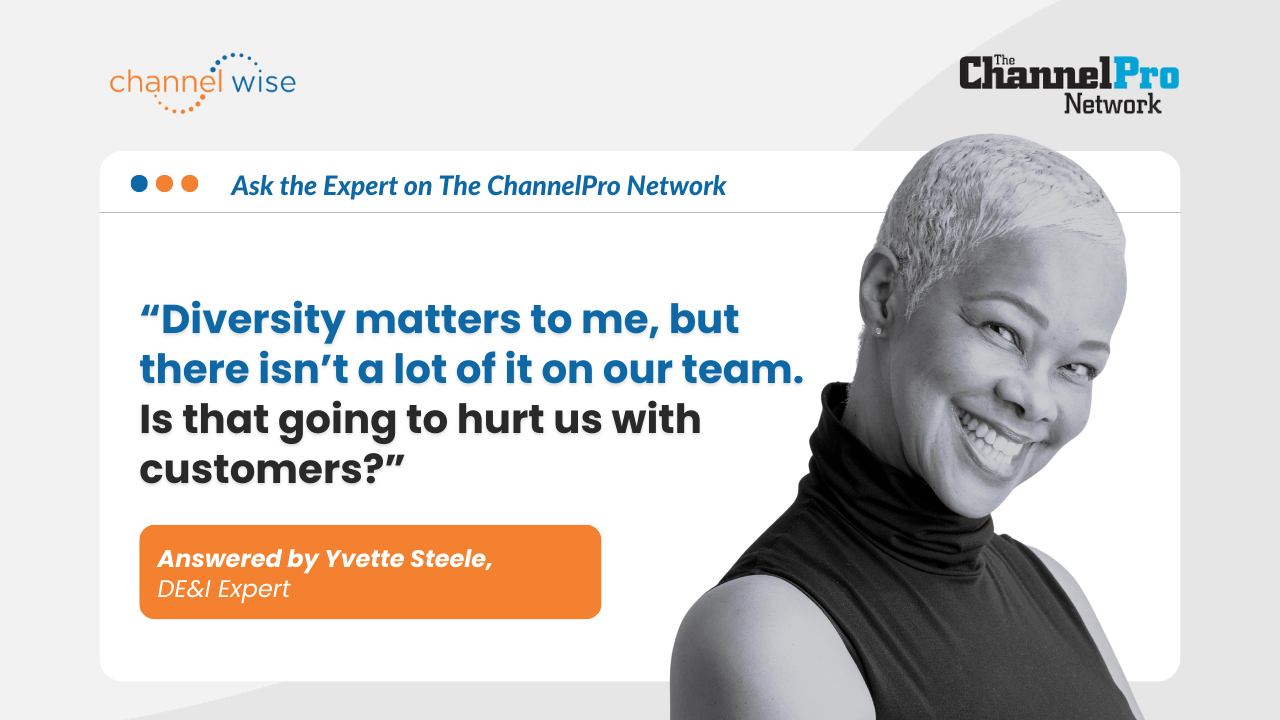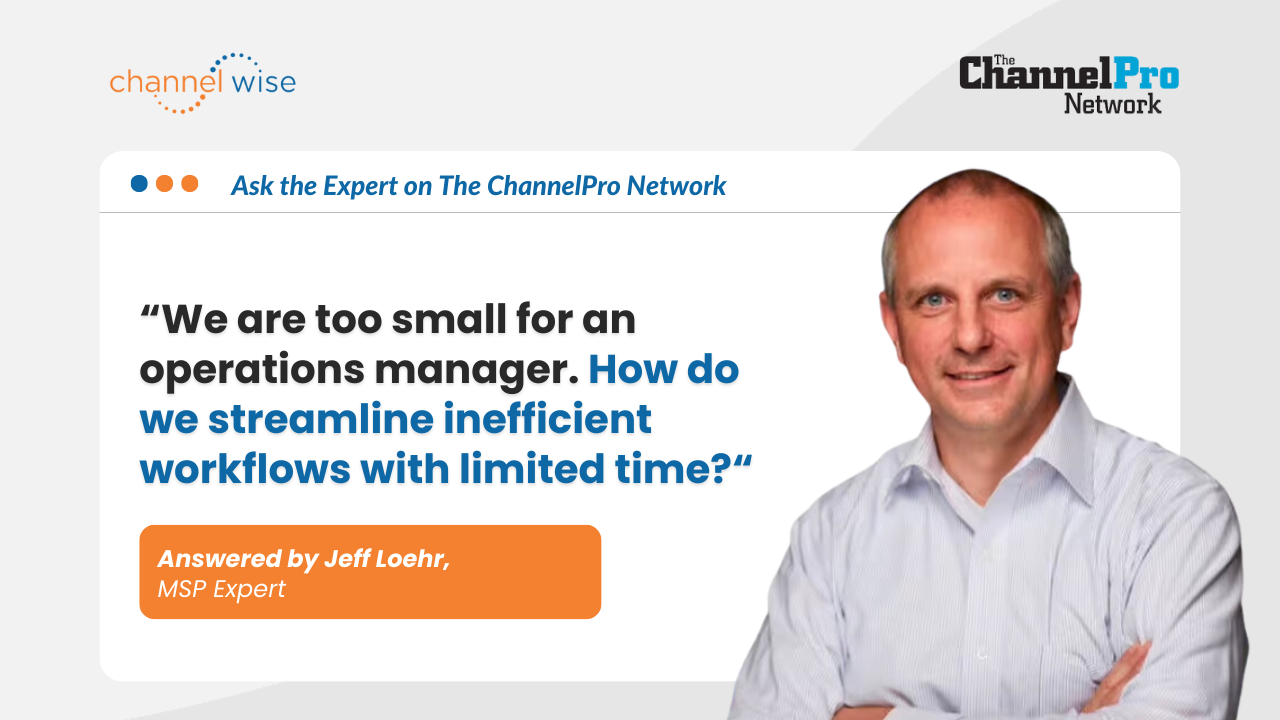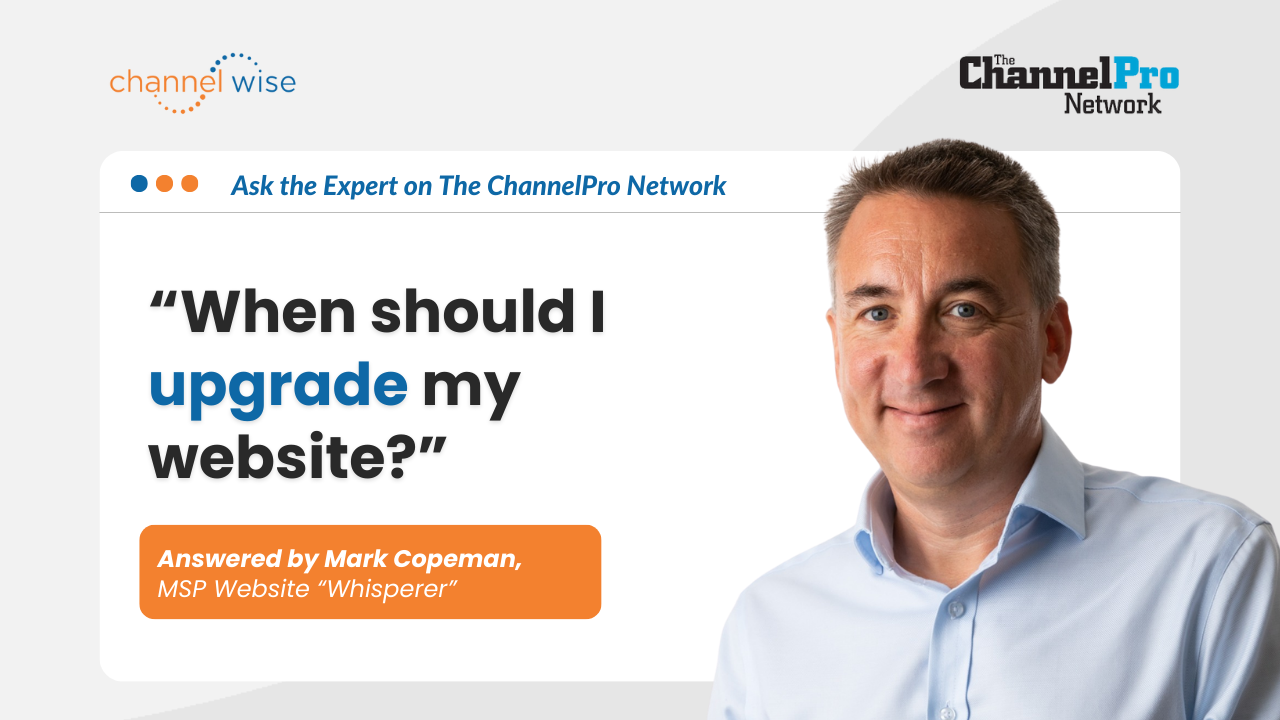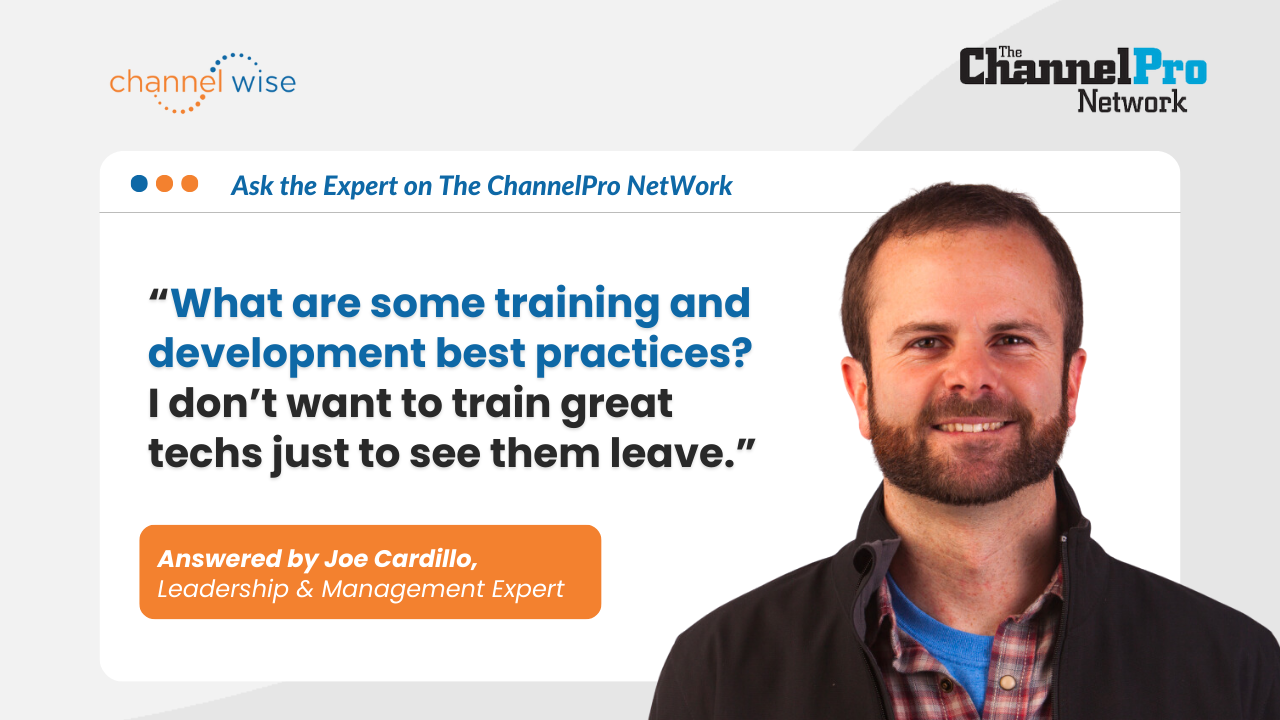channelWise Blog

One of the biggest marketing challenges I see with managed services providers is identifying the right marketing channels and tactics. Navigating the maze of marketing tools can be a daunting task for MSPs. Here are some of my favorite tools that won’t have you digging deep into your pockets: Interview Your Ideal Clients Have you ever thought about simply having a chat with your ideal clients? It’s a classic, cost-effective way to understand what your clients really need and want. Engaging them in interviews can unveil their preferences, needs, and challenges straight from the horse’s mouth. And it’s free. Incorporate Tools Like ChatGPT AI has been making waves in the marketing sphere, and one tool that stands out is ChatGPT. This multipurpose tool can assist with content creation, SEO optimization, email marketing support, and more. Start with a free plan, and if it meets your needs, the paid plans kick off at $20 per month. Google Analytics & Search Console For a deeper dive into your website’s performance, Google Analytics is your go-to tool. It’s a treasure trove of data, offering insights into traffic, user behavior, and the effectiveness of your marketing campaigns – all for zero cost. Alongside it, Google Search Console can be your ally in optimizing your site’s visibility on Google, also without costing a dime. Try Ubersuggest SEO is a linchpin for online visibility, and Ubersuggest is a solid, budget-friendly option for keyword research, site audits, and competitive analysis. It has a free version, but its paid plans are competitively priced starting at $29 per month or a one-time payment of $290. Shore Up on LinkedIn LinkedIn, the haven for B2B marketing, is a social media platform you shouldn’t overlook. It’s a formidable space for networking, sharing insights, and flaunting your MSP services to a professional audience. Basic usage is free, but if you fancy more features, premium plans are available at a cost. Email Marketing Despite being a veteran in the digital marketing arena, email marketing still holds its ground as a cost-effective channel. Platforms like Active Campaign, Mailerlite, Mailchimp, ConvertKit, and Aweber are notable mentions. Their pricing starts at $10 to $20 monthly. Incorporating these tools can serve as a catalyst in refining your marketing operations, understanding your audience better, and fostering a stronger connection with them without burning a hole in your pocket.

Today’s customers want to see themselves reflected in the companies they support. Research has shown that a lack of diversity within teams is detrimental to business development and customer relationships, especially when your customer base is diverse. The primary reason that diverse teams are critical to the success of client engagement is due to the unique experiences and intersectionality of the varied perspectives each team member brings to the table. This opens the door to more creativity and improved problem solving that your customers expect from you, which leads to greater customer satisfaction. Your ability to connect with customers thrives on your capacity to deliver fresh perspectives and how well you anticipate and respond to their needs. The more your team is representative of the markets they serve, the more valuable their insights become – and you can create better solutions for your client. Lack of Diversity Stifles Progress Consider the backlash experienced by big brands that create racially or culturally insensitive ads or products. Chances are no one with a varied perspective was present in strategy meetings to challenge the status quo. Perhaps you have personally experienced a client interaction where you or a peer unwittingly disregarded the position and authority of the primary decision maker based on their race, age, gender, or other misguided assumptions due to a lack of cultural competence. It happens all the time but it doesn’t have to. Diversity is less about how a person looks or where they come from; it’s more about valuing different points of view and being open to exploring new ways of thinking. It’s about integrating diversity of thought, which comes from the unique backgrounds and experiences of diverse individuals. By contrast, homogeneous teams are composed of individuals with similar backgrounds, perspectives, and experiences, which often subjects them to groupthink, blinds them to new opportunities, and hinders exploration of unconventional approaches. Thus, you’ve inadvertently stifled the very progress you aim to achieve. Create Your DEI Strategy As you plan your next client interaction or strategy meeting, ask yourself these questions: How well do we understand the unique needs, preferences, and challenges of diverse customer segments and/or buyers? Which team members’ perspectives are missing? Why are they not in the room? How can we adjust our thinking to better connect with our clients and their needs? The responses to these questions position you to address the gaps, better relate to your customers and their unique challenges, and help them innovate. A diverse team is better equipped to do just that.

I see this problem all the time: You’re overworked, can’t keep up with tickets, the phone is ringing, and there is no time for anything other than fighting to keep your head above water. However, if you don’t change anything, you will never break free. Even hiring an office manager won’t help because if you haven’t taken the steps to create a business machine, they’ll end up increasing your workload rather than reducing it. So, how do you create a machine? Here are some recommendations. Focus Your Operations Start by streamlining workflows through repeatable processes, then document them as you work. The most common source of inefficiency is solving many problems for many kinds of customers. You will be spread very thin and will never catch up if you work with accountants who have issues with Thomson Reuters, QuickBooks, and Liscio; doctors who struggle with Epic; and architects who need to make Papercut and AutoCAD work. The key to mechanization is focus. Get spectacular at solving a few critical problems for very specific markets. Focus cuts work out of your process and reduces work throughout the business. Make Time to Document A lack of time is a problem for many businesses, but you don’t have time to not document. Undocumented processes take two to three times longer to complete – sometimes much more – because you figure it out each time. A lack of documentation is why hiring an office manager won’t help. One of my clients passionately resisted documentation. They were drowning in tickets, unsatisfied customers, and unfinished projects. They also suffered from a lack of sleep. Documenting the first process was hard, but now, they have 5,000 processes documented. Trailing tickets were reduced by 93%, revenue tripled, they hired a team that delivers impressive results, and they take vacations without their phones. Use Automation Tools The third piece is automation. But you cannot automate a process you haven’t defined. That creates a mess and endless work. Once you have something defined, automate it. PSAs and RMMs have self-healing scripts and scripts for common problems that can save oodles of time. Ensure you set proper thresholds so you can detect issues before they escalate. This takes out randomness. Automate ticket assignments and responses, and create canned answers for the top 50 things your techs respond to. Plus, with open APIs, compatible tools, and tools like Zapier, you can automate an almost endless list of routine office tasks: Proposal creation and delivery Follow-up processes QBR (SBR) scheduling Sending birthday cards By incorporating these strategies, even time-strapped small companies can reduce burdensome workloads.

When you’re trying to determine if it’s time to upgrade your company’s website, it’s important to first understand if your website works for you. Is it driving leads? More importantly, are those leads turning into clients? If so, then you are probably good. But if you’re like most of the 400-plus MSPs’ websites I reviewed over the last two years, then you probably are not getting the results you should be getting. But before you go near a keyboard or mouse – or worse, hire someone to redo your site – the fundamental questions around proposition, direction, and target market need to be answered. Making the decision to rebuild a site is so much more than a design exercise. It’s an exercise in figuring out what your business is all about and where it’s headed. Think of your site as a storefront window. It’s where potential clients first encounter your brand, learn about your services, and, most importantly, decide whether they want to engage with your business. An outdated or ineffective website can have a significant impact on your ability to start those new conversations. So, when do you know it’s time for a new website? Here are some overall thoughts: Outdated Design The visual appeal of your site plays a crucial role in attracting and retaining visitors. An outdated design can turn potential clients away. You only have one chance to make a first impression. If your site looks like it hasn’t seen an update in years, it’s probably time for a refresh. I’ve seen too many sites that look like they were designed when we were still sending faxes or are a barely customized template. It’s almost 2024. Don’t let that be yours. Ineffective Content, No SEO Your site’s content should be informative, engaging, and relevant to your target audience. It should be personal, too. It should tell stories about your business and how you’ve helped your clients. In addition, is your site getting traffic for local geographic search terms? Are you missing out on organic visitors? If SEO is non-existent. It’s time for a refresh. Low Conversion Rates If you’re getting visitors, but those contact forms are not coming through, then your calls to action aren’t doing their job. Make them clear and always sell your credibility on relevant landing pages. Talk to me if you’re not sure how to make that happen. Domain or Business Name You are what you are online. If your business can’t be found easily, change it. It’s that simple. Be unique. Be found. If you’ve noticed any of the signs flagged above, it likely is time to consider investing in a refresh.

As a leadership and coaching expert, my primary focus is on supporting individuals who experience burnout. Burnout is especially common in high-stress roles like engineering. However, there are several steps I recommend to make things better for your lead engineer . Foster Open Communication It’s crucial to create a safe, nonjudgmental space where your lead engineer feels comfortable discussing their burnout and its underlying causes. By actively listening and showing empathy, you can help them feel heard and understood. Manage Expectations It’s important to review their workload and expectations. Burnout often stems from an overwhelming amount of work. Take the time to assess their responsibilities and workload, and identify areas where improvements can be made. This might involve redistributing tasks, delegating when possible, or even considering hiring additional resources to lighten the load. Work/Life Balance Encouraging work/life balance is another vital aspect. Help your lead engineer establish healthy boundaries by promoting regular breaks, time off, and the ability to disconnect from work during non-working hours. Demonstrating the importance of personal time and well-being through your own actions is key. Tools and Support Providing resources and support also is crucial. Ensure your lead engineer has the necessary tools and resources to perform their job effectively. Consider offering additional training, mentoring, or coaching to enhance their skills and boost their confidence. Employee assistance programs, counseling services, or wellness initiatives can also provide valuable support. The Culture Criteria Cultivating a positive work culture is essential in preventing burnout. Encourage collaboration, recognition, and appreciation among team members. Celebrate successes, share achievements, and foster an environment where everyone supports one another. Recognizing your lead engineer’s contributions and offering regular constructive feedback will contribute to a positive work environment. Empowerment Through Autonomy Promoting autonomy and flexibility can help combat burnout. Grant your lead engineer more control over their work whenever possible. Empowering them with decision-making authority and exploring flexible work arrangements, such as remote work or flexible hours, can improve their well-being and job satisfaction. Check In Often Regularly monitoring goals and revisiting them is crucial. Check in with your lead engineer frequently to assess their progress and adjust goals as needed. Collaboratively setting realistic and achievable targets, considering their workload and well-being, will help reduce overwhelm and increase motivation. Truly Listen to Feedback Seek feedback and be open to iteration. Ask your lead engineer for their insights, challenges, and suggestions for improvement. Involve them in finding solutions and implementing changes. Continuously assessing the effectiveness of the strategies you’ve implemented and adapting as needed is key to addressing burnout successfully. By implementing these strategies and demonstrating genuine care and support, you can create a healthier work environment that fosters well-being, productivity, and job satisfaction for your lead engineer and the entire team.

There are two reasons why MSPs fail to attract prospects: Potential prospects don’t know you exist. Those who do know don’t understand that you solve a problem they have. Spending time, money, or resources on Point 1 is a waste without Point 2, so start there. The problem is that most MSPs sell something nobody wants to buy: IT services. Potential prospects have IT issues but are unaware that they are IT issues, aren’t interested in IT, and/or don’t speak tech. They don’t know how your IT services solve their problems. This leads to confusion and not buying. Overcoming Confusion So, how do you get uninterested potential customers attracted to your offerings? Answering these three questions can help you: Who is your target market? This can be a vertical, but a vertical often is too broad. So, it more likely will be a sub-part of a vertical. What problem do you solve for your target market using technology? This is an objective your target market has and a reason they can’t achieve it. They have business problems, not IT problems. How will you talk about it in their language? Use prescriptive sales: Start with the problem in their language, then accentuate the pain of the problem, present a solution, discuss the transformation, and make an offer. Without clear, tested, and optimized answers to these questions, you shouldn’t spend any money on advertising. It doesn’t work. So, answer the questions first. The good news is the answers make connecting with prospects easier. Instead of talking to everybody about something no one cares about, you speak to a specific audience about a problem vital to them. Right Place, Right Time The next step is to find prospective customers by going to where they are: Attend conferences and shows. If you solve a problem for dentists, go to dentistry conferences, not MSP conferences. Use social media. Identify 100 attractive prospects on LinkedIn, and target them with customized outreach through social media, mail, email, phone calls, and office visits. Add to the list as you close clients or eliminate someone as a prospect. If you spend money on awareness, spend money here. Network. Identify your top 250 contacts, make them aware of your target market and the problems you solve for them. Since what you do is no longer confusing, they can make introductions. Create content: Write for publications, newsletters, blogs, and whatever else you can find that your target market reads. Evolve into Marketing If you’ve answered the first three questions above and followed the next steps, you will attract customers. Once you’ve perfected your sales process, you can consider marketing. There are no silver bullets; there isn’t one thing you can do that magically works. I’ve tried it all; this is the strategy that works.

An ineffective budget is a common problem. Here are seven suggested solutions to some typical MSP missteps when it comes to budgeting. Keep Clean Books: If you aren’t keeping track of what’s happening, you can’t measure yourself against a budget. To make sure you are keeping your books, outsource the task. It isn’t expensive – and you have better things to do. Plan Ahead: Some business owners wrongly believe a budget belongs in their heads or consists of balancing their bank accounts at the end of the month. A budget is a plan. Create a budget, even if it’s not perfect. Measure Performance: Even a perfect budget is a waste of effort and bytes if you don’t regularly measure your performance against it. Monthly measurement seems to work well for most businesses; fast-moving businesses may need to do it more often. Be Realistic: Your budget should include all expected expenses, including the owners’ salaries. Your business should pay you, and that payment should be in the budget. Include tools, contractors, rent, utilities, sales, marketing, and all other expenses. Include escalations: rent will likely go up, and tool prices may increase, especially as your customer base grows. Also, perfect budgeting is impossible, so add a buffer to your expenses. If adding all these expenses puts you in a negative cash flow situation, treat this as a problem to solve, not a budget item to ignore. Timing matters: Think about when you will incur expenses. If you pay $2,000 for a tool every September, include this as an expense in September. Do not average it out to $167 a month. Smoothing out your expenses gives you an unrealistic view of your cash flow and leads to unwelcome surprises. Figure In Revenue Growth: If you plan to grow your customer base next year, how will you do it? What costs will you incur? Plan those costs, and as you go through the year, measure your cost of acquisition. Likewise, if you want or need to grow revenue, how will you do it, and what will it cost? Remember Your Taxes: Your tax situation depends on several factors. Work with your tax professional/accountant/bookkeeper to determine the right way to plan for taxes. Unexpected tax bills at the end of the year are killer. Along these lines, make sure you have the correct legal entity for your business. These seven issues come up often. I recommend considering them as you plan your budget and measure your performance throughout the year.

Sure, it can feel uncomfortable to outsource your voice, especially when there’s so much talk about being authentic online. That said, it is common to at least have some content being posted on your behalf. Being consistent on social media is one of the best ways to stay in front of your prospects and customers. But you only have so much time to do it, so hiring someone who can capture your thoughts and ideas and communicate them effectively with the world isn’t anything new. If you look at some of the top nonfiction books on Amazon, according to ghostwriters’ literary agent Madeleine Morel, at least 60% of those books are ghostwritten. That’s because many of the recognized names on the covers either lack the time or, more commonly, the writing skills to author a book. It’s important to understand that your content team isn’t reinventing you; they’re crafting content based on your viewpoints, insights, and ideas. This distinction is what separates genuine representation from what may be perceived as deception. But if you’re thinking about outsourcing your voice, here are some things to consider: Define What You Want to Outsource How do you want to show up online? What kinds of things do you want the content team to post about? Perhaps they are just posting industry reports, quotes, or carousels of ideas, and you take on a once a day or week approach to write some of your own posts that express your views and voice. Employ a Tactic Like Journaling Journaling is a great way to refine your thoughts before expressing them publicly. Reflecting and revisiting your thoughts ensures they’re clear and precise when presenting them publicly or directing a ghostwriter or poster to do it for you. You can use something as simple as the Voice Memos app on your phone to capture your thoughts. Schedule Regular Check-Ins with Your Content Team Even if you don’t have time to post to your social media accounts regularly, you must be disciplined and committed to generating engaging content. Despite what you may have heard, there’s no Crock-Pot strategy for your thought leadership efforts. Simply put, you get what you put in. While your content team does the heavy lifting, you have to meet them halfway – and then some. Ultimately, they’re relying on you for your unique perspective. Without you providing insights on your industry, area of expertise, and business, you leave your content team to generate ideas on their own – and that may not be ideal. Avoid this by scheduling a recurring meeting with your content team to generate ideas. Share what’s been on your mind, even if it’s only an hour a month. Noteworthy Webinars, Articles, and Discussions The more material your content team can pull from, the better. If you’ve authored articles or been quoted in stories, pass these along to your content team. Encourage them to attend the webinars you’re part of, or to catch you on conference panels. They need to understand your thoughts, phrasing, and personality. Do anything you can to make your content team generate more authentic content. While sharing content on your social media accounts is only a part of your thought leadership efforts, it’s essential. Customers, prospects, and industry peers spend much of their days scrolling on their phones, so having a content team behind you to effectively communicate your messaging puts you in a better position to grab their attention and bolster recognition.

Keeping your best employees engaged is one of the most essential elements of managing a team. Recent tech layoffs and service industry hiring challenges illustrate that workers are thinking more carefully about if and when to stay in a job. While salary/pay and benefits matter, employee engagement is also vital. Most of us want to feel some combination of effectiveness as individuals and shared purpose as a team. Training and professional development can address both areas. Three key ways for managers to do this include developing a sense of purpose, actionable metrics, and shared decision making. Principle 1: Consistently Talk About the ‘Why’ Creating shared purpose is one of the strongest ways to connect employees to an organization’s goals and values without being prescriptive or micromanaging. An example scenario is you manage a team of techs doing speed/quality checks for customers, and an organizational goal is to encourage self-education. There’s a checklist or workflow, but since customer needs vary, so do solutions. Option A: Use 15 minutes of a weekly team call or post weekly in a dedicated “The Whys” messaging channel to share how a situation connects to the larger goal of helping customers self-educate. Option B: Share one example and ask your team to do the same. This makes training and coaching less abstract, and more concrete and relatable. You’ll have to experiment to see what works for your team, but when done consistently, this helps employees connect to the bigger picture and feel valued. Principle 2: Use An Actionable Scorecard Model Great managers know what we measure is what we focus on. Employees feel more engaged when they have clear goals, and can control or change the inputs to get there. Some characteristics of an actionable scorecard: Static milestones and goals, but inputs are flexible Enables the person closest to what works or not to change inputs and make choices Provides clarity instead of overly focusing on penalties or rewards Did your salesperson discover a new tactic to increase demo signups? Sounds like an opportunity for a one-on-one about updating their scorecard so they can invest more in those areas. Principle 3: Create Opportunities for Shared Decision-Making For managers, sharing power takes practice. Many of us aren’t taught how to do this because our families, schools, and workplaces are hierarchical. But when employees are involved in decision making, we’re also more likely to feel a sense of responsibility, accountability, and connection to the work. Here are examples that involve PTO and scheduling: Top-down model: Everyone asks the manager for time off, they look at workloads, who has time off scheduled, etc., and make the decision. Shared-decision model: Everyone can access the calendar and discuss time off/coverage in a group setting. The manager provides advice or guidance but allows employees to organize based on team needs. Not every company or organization has flexibility in this specific area, but similar activities — like peer mentoring and employee-led training — can increase employee engagement. All three of these core principles take practice, but can positively impact your team and business on multiple levels, leading to engaged employees who are more likely to stick around.

